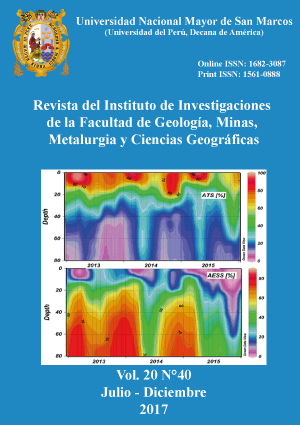Chemical characterization of three lignocellulosic residues generated in the Canton Alausi region
DOI:
https://doi.org/10.15381/iigeo.v20i40.14393Keywords:
Chemical characterization. Agroindustrial wastes, lignocellulosic residues, fungi lignocelulolític.Abstract
The objective was to characterize and determine the chemical composition of three types lignocellulosic waste generated in the region of the canton Alausí Sinancumbe sector pod vetch, wheat straw and bagasse corn. For determining the chemical composition Weende method comprising analyzing the fractions applied moisture, crude protein, crude fiber, crude fat, ash and nitrogen-free extract (ELN) .and for determining lignin cellulose and hemiceluosa Klason method and cellulose Kurschner and Hoffer. The use of agro-industrial waste generated in processes is of interest worldwide. Today is investigated in lignocellulosic for energy, fuels, bio-chemicals and obtaining unconventional protein, using clean technologies and closed systems that conserve the environment biomass.
Residues in triplicate were determined chemical composition and morphological properties. Based on these residues results have suitable for use as suitable substrates for the cultivation of edible fungi, the presence and concentration of lignocellulosic biopolymers, 14.4% lignin, cellulose 38.7% 30.0% hemicellulose and chemical characteristics in wheat straw, with 13.1% lignin, cellulose 44.9% 28.4% hemicellulose and in the pea pod and 10.1% lignin, cellulose and 28.3% hemicellulose 25.0% corn bagasse, which can be hydrolyzed by the action of this multienzyme system in lignocelulolític fungi.
Downloads
Published
Issue
Section
License
Copyright (c) 2017 Iván Ramos Sevilla

This work is licensed under a Creative Commons Attribution-NonCommercial-ShareAlike 4.0 International License.
AUTHORS RETAIN THEIR RIGHTS:
a. Authors retain their trade mark rights and patent, and also on any process or procedure described in the article.
b. Authors retain their right to share, copy, distribute, perform and publicly communicate their article (eg, to place their article in an institutional repository or publish it in a book), with an acknowledgment of its initial publication in the Rev. Inst. investig. Fac. minas metal cienc. geogr.
c. Authors retain theirs right to make a subsequent publication of their work, to use the article or any part thereof (eg a compilation of his papers, lecture notes, thesis, or a book), always indicating the source of publication (the originator of the work, journal, volume, number and date).






